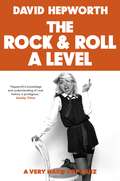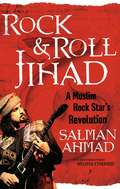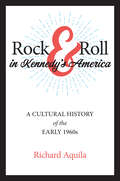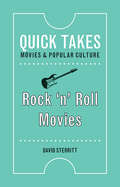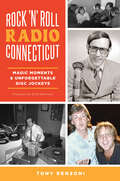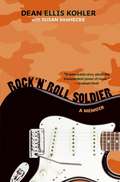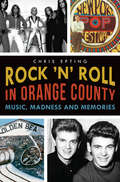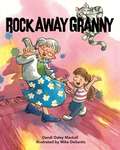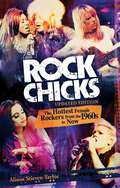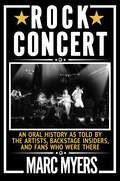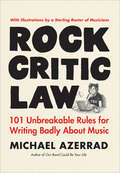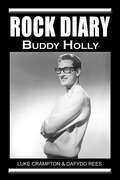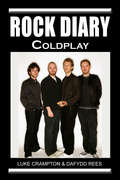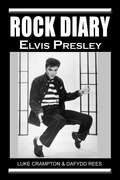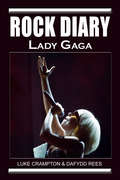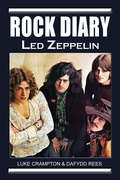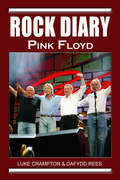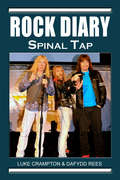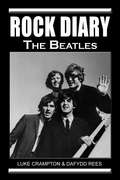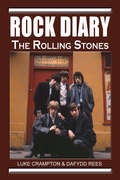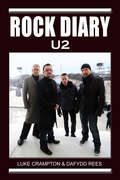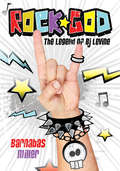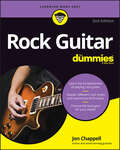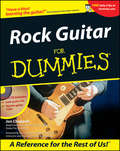- Table View
- List View
Rock & Roll A Level: The only quiz book you need
by David HepworthThe perfect gift for any music lover . . . 'Hepworth has more insider knowledge and knows more rock anecdotes than any man alive' The Herald'Unmissable for music enthusiasts' Woman & HomeThe Rock and Roll A Level is here to rescue the pop quiz from the grip of bores who know the chart position of everything and the value of nothing.It's for the people who like pop music because it tells them so much about real life, the people who learned about America from the songs of Chuck Berry, about Europe from the albums of David Bowie and about all manner of things from the songs of Steely Dan.It's the first quiz book where the answers are as interesting as the questions.It's the first quiz book where general knowledge matters as much as an adolescence spent reading the NME or Smash Hits.It's a proper education.
Rock & Roll Jihad
by Salman AhmadMemoir by a Pakistani doctor, Moslem rock star, and UN Ambassador, who embarks on a quest to unite the Western world and Islam through music.
Rock & Roll in Kennedy's America: A Cultural History of the Early 1960s
by Richard AquilaA rousing, poignant look at the cultural history of rock & roll during the early 1960s.In the early 1960s, the nation was on track to fulfill its destiny in what was being called "the American Century." Baby boomers and rock & roll shared the country's optimism and energy. For "one brief, shining moment" in the early 1960s, both President John F. Kennedy and young people across the country were riding high. The dream of a New Frontier would soon give way, however, to a new reality involving assassinations, the Vietnam War, Cold War crises, the civil rights movement, a new feminist movement, and various culture wars.From the former host of NPR's Rock & Roll America, Richard Aquila's Rock & Roll in Kennedy's America offers an in-depth look at early 1960s rock & roll, as well as an unconventional history of Kennedy's America through the lens of popular music. Based on extensive research and exclusive interviews with Dion, Bo Diddley, Brenda Lee, Martha Reeves, Pete Seeger, Bob Gaudio, Dick Clark, and other legendary figures, the book rejects the myth that Buddy Holly's death in 1959 was "the day the music died." It proves that rock & roll during the early 1960s was vibrant and in tune with the history and events of this colorful era. These interviews and Aquila's research reveal unique insights and new details about politics, gender, race, ethnicity, youth culture, and everyday life. Rock & Roll in Kennedy's America recalls an important chapter in rock & roll and American history.
Rock 'n' Roll Movies (Quick Takes: Movies and Popular Culture)
by David SterrittRock ‘n’ Roll Movies presents an eclectic look at the many manifestations of rock in motion pictures, from teen-oriented B-movies to Hollywood blockbusters to avant-garde meditations to reverent biopics to animated shorts to performance documentaries. Acclaimed film critic David Sterritt considers the diverse ways that filmmakers have regarded rock ‘n’ roll, some cynically cashing in on its popularity and others responding to the music as sincere fans, some depicting rock as harmless fun and others representing it as an open challenge to mainstream norms.
Rock 'n' Roll Radio Connecticut: Magic Moments & Unforgettable Disc Jockeys
by Tony RenzoniConnecticut radio stations and their charismatic disc jockeys played an integral role in the history of rock ‘n’ roll. They served as a vital connection between the music and their audience, providing listeners the one vehicle they most needed—a format for them to listen to their favorite songs. Learn about such memorable moments as the fierce rivalry between WDRC and WPOP, the zany antics of Joey Reynolds, and the on-air “death” of Lee “Baby” Simms. WPLR emerged as a “town hall meeting held in a frat house,” and colorful skits filled the airwaves. With in-depth interviews and timeless photos, author Tony Renzoni captures the spirit of the vibrant music scene and traces the important and influential role of past and present on-air personalities.
Rock 'n' Roll Soldier: A Memoir
by Dean Ellis Kohler Susan Vanhecke"During a time when none of us knew for sure if we would live or die, I came to know the true power of music." Dean Kohler is about to make it big -- he's finally scored a national record deal! But his dreams are abruptly put on hold by the arrival of his draft notice. Now he's in Qui Nhon, Vietnam, serving as a military policeman. He keeps telling himself he's a musician, not a killer, and that he's lucky he's not fighting on the front lines. When Captain orders him to form a rock band, it's up to Dean to find instruments and players, pronto. Ingenuity and perseverance pay off and soon the band is traveling through treacherous jungle terrain to perform for troops in desperate need of an escape -- even if it's only for three sets. And for Dean -- who lives with death, violence, and the fear that anyone could be a potential spy (even his Vietnamese girlfriend) -- the band becomes the one thing that gets him through the day. During one of the most controversial wars in recent American history, this incredible true story is about music and camaraderie in the midst of chaos.
Rock 'n' Roll in Orange County: Music, Madness and Memories (Music Ser.)
by Chris EptingThe great acts--from Hendrix to Joplin and from Kiss to Korn--played to the Orange County crowd at such classic venues as Huntington Beach's Golden Bear, the Anaheim Convention Center and Anaheim's Doll Hut. Rock 'n' roll's OC roots include Leo Fender's electric guitar factory in Fullerton and the birthplace for the garage-band standard "Louie Louie" in Anaheim. As the music changed, iconic OC groups like Social Distortion and Avenged Sevenfold helped lead the way. Final curtains came down here, too: though killed in England, Eddie Cochran is buried in Cypress, and Bobby Hatfield, half of the Righteous Brothers, is interred at Corona del Mar. Join pop culture expert Chris Epting for the essential big hits plus idiosyncratic flip-side riffs of Orange County's mighty rock 'n' roll history.
Rock Away Granny
by Dandi Daley Mackall Mike DeSantisGetting dropped off at Grandma’s house could be a total snooze. Hours of sitting in the rocking chairs. But not this Grandma. Up she hops to wheel out the record player. And then, with kitty as the DJ—a dance party! The twist, the swing, the Monster Mash—they rock, rock, rock, at Granny’s house tonight. Then right as Mom returns, everyone crashes out in the rocking chairs. Just another boring night at Grandma’s (Mom thinks). Wink!Includes pictures of easy to follow dance steps like the side pass, cuddle, and underarm turn.
Rock Bottom: Dark Moments in Music Babylon
by Pamela Des BarresThe dark moments of rock history fascinate and tantalize like the pathos of Greek tragedy. The bottom sinks lower, the air seems colder, the bad endings--when they are bad--seem beyond bad. The unlucky practitioners of our most thriving form of communal experience seem to hit rock bottom in ways only the most glamorous among us can--publicly. The stories remain obscure, half-seen in the shadowlands. In her familiar style, Pamela Des Barres shines light on the people whose art remains the background music to our popular culture.Des Barres asks, "What comes first, the addiction or the rock and roll?" The first apparent rock-and-roll death occured on Christmas Eve in 1959, when Johnny Ace blew his head off in a game of Russian Roulette between shows. Buddy Holly's four-seater plane crashes. Marvin Gaye's father shoots his son. Kurt Cobain puts a gun to his head. The headlines tell it all: ROCK SINGER FACES MANSLAUGHTER CHARGE, JAMES BROWN ADDICTED TO PCP, BASSIST FOR BAND HOLE FOUND DEAD. The messed-up lives, the burned-out golden boys and girls, the violence, the route toward rock bottom--Des Barres has a line on the souls of the public figures who lived desperate private lives to entertain us all.
Rock Chicks: The Hottest Female Rockers from the 1960s to Now
by Alison Stieven-TaylorBrave: Courageously live your truth sets out a clear roadmap for women to reclaim their personal power, providing them with the knowledge and courage to step into an authentic life. Learn how to listen to your intuition, follow your soul purpose and bravely live your truth. This book helps to identify your personal calling, recognising a destiny that yearns to be fulfilled and provides the skills to recognise the power and courage within to take the leap towards a more meaningful and passionate life. This book is for the woman who feels lost in the midst of all the small decisions in her life. Be it following a career path, climbing the corporate ladder or caring for family, sometimes your focus, personal beliefs and goals get lost in the day to day. Now is the time to identify your personal calling and rediscover the destiny that is meant for you alone.
Rock Concert: An Oral History as Told by the Artists, Backstage Insiders, and Fans Who Were There
by Marc MyersA “fascinating, intimate” oral history of the golden age of the rock concert based on nearly 100 interviews with musicians, fans, and others (Publishers Weekly).Decades after the rise of rock music in the 1950s, the rock concert retains its power as a unifying experience—and as a multi-billion-dollar industry. In Rock Concert, acclaimed music writer Marc Myers delves into the history of this cultural phenomenon, weaving together ground-breaking accounts from the people who were there.Myers combines the tales of icons like Joan Baez, Ian Anderson, Alice Cooper, Steve Miller, Roger Waters, and Angus Young with the disc jockeys, audio engineers, and music journalists, and promoters who organized it all, like Michael Lang, co-founder of Woodstock, to create a rounded and vivid account of live rock’s stratospheric rise.Rock Concert offers a backstage view of rock ‘n’ roll as it evolved through live performance—from the rise of R&B in the 1950s, to the hippie gatherings of the ‘60s, and the growing arena tours of the ‘70s and ‘80s. Elvis Presley’s gyrating hips, the “British Invasion” of the Beatles, the Grateful Dead’s free flowing jams, and Pink Floyd’s The Wall are just a few of the defining musical acts that drive this rich narrative.
Rock Critic Law: 101 Unbreakable Rules for Writing Badly About Music
by Michael AzerradStraight out of his beloved Twitter feed @RockCriticLaw, acclaimed rock journalist and author of the classic books Come As You Are: The Story of Nirvana and Our Band Could Be Your Life, Michael Azerrad turns his trenchant eye to the art of rock writing itself, hilariously skewering 101 of the genre’s seemingly endless litany of hackneyed phrases and tropes.One of the finest music writers today, Michael Azerrad has catalogued the shortcuts, lazy metaphors and uninspired prose that so many of his beloved colleagues all too regularly rely on to fill column inches. In 2014, he began his wickedly droll Twitter feed @RockCriticLaw to expose and make fun of this word-hash. Now, he consolidates these "Laws" into one witty, comprehensive and fully illustrated volume.Rock Critic Law includes timeless gems such as:If a band pioneered something, you must say they are "seminal." That is the Seminal Law of Rock Criticism.If a recording features densely layered guitars, then you MUST use the phrase "sonic cathedrals."Even when it’s easy to find out with research, by all means ask a band how they got their name.Please feel free to deny an artist’s individuality and say they are "the new [x]."If two guitars play a melodic line in harmony, you MUST say they are "twin lead guitars."All 101 Rock Critic Laws are accompanied by original illustrations from Ed Fotheringham, beloved Seattle scenester and highly regarded artist who has created album covers for everyone from, well, seminal grunge band Mudhoney to iconic jazz label Verve Records, as well as illustrations for TheAtlantic, Vanity Fair, The New Yorker and more, making this book a must-have for music lovers everywhere. A unique appreciation of music writing from one of its own, Rock Critic Law irreverently captures all the passion and furor of fandom.
Rock Diary: Buddy Holly
by Dafydd Rees Luke CramptonRock Diary: Buddy Holly is a unique, chronological, day-by-day, month-by-month and year-by-year history of the life and career of one of the most popular and influential musicians of all-time. This definitive factual story is the ultimate biographical timeline of one of the architects of rock 'n' roll - from his earliest days as a teenager in Lubbock, Texas through his phenomenal rise as one of America's leading rock pioneers to his tragic early death on the 'day the music died'. Also a continuing timeline on the events and triumphs which make up Holly's astonishing legacy, right up to the present day. Every Holly fact, each recording session and tour, television and radio appearances, all US and UK singles and albums chart and gold/platinum sales achievements, every award ever won, his personal highs and lows - all are included in this detailed, comprehensive rock diary. Simply the best value for the complete history - and backstory - of this iconic star. This is the second volume in the unrivaled Rock Diary series which also includes individual, comprehensive biographies on all the rock greats including the Beatles, the Rolling Stones, Elvis Presley, Pink Floyd, U2, Coldplay, Led Zeppelin, Lady Gaga - even Spinal Tap.
Rock Diary: Coldplay
by Dafydd Rees Luke CramptonRock Diary: Coldplay is a unique, chronological, day-by-day, month-by-month and year-by-year history of the life and career of one of the most popular rock bands of the 21st century. This definitive factual story is the ultimate biographical timeline of the British quartet of Chris Martin, Jonny Buckland, Guy Berryman and Will Champion - from their earliest days as London college students in the late 1990s to their meteoric rise as one of the world's top acts. Every Coldplay fact, each recording session and tour, television, film and radio appearances, all UK and US singles and albums chart and gold/platinum sales achievements, every major award ever won, music videos, solo side projects - all are included in this highly-detailed, comprehensive rock diary. Simply the best value for the complete history - and backstory - of this iconic band. This is the eighth volume in the unrivaled Rock Diary series which also includes individual, comprehensive biographies on all the rock greats including U2, the Beatles, the Rolling Stones, Elvis Presley, Pink Floyd, Buddy Holly, Led Zeppelin, Lady Gaga - even Spinal Tap.
Rock Diary: Elvis Presley
by Dafydd Rees Luke CramptonRock Diary: Elvis Presley is a unique, chronological, day-by-day, month-by-month and year-by-year history documenting the complete history of the most popular performer of the rock era. This definitive factual story is the ultimate biographical timeline of The King - from his earliest blue collar days in Tupelo, Mississippi and Memphis, to his unmatched rise to lead the freshman class of rock 'n' roll, from his film career in Hollywood to his astonishing live comeback, and his subsequent sad decline and death. Also a continuing, detailed timeline on the events and triumphs which make up Presley's extraordinary legacy, right up to the present day. Every Elvis fact, each recording session and tour, television, film and radio appearances, all US and UK singles and albums chart and gold/platinum sales achievements, every major award, his personal highs and lows and family life - all are included in this detailed, comprehensive rock diary. Simply the best value for the complete history - and backstory - of this iconic star. This is the second volume in the unrivaled Rock Diary series which also includes individual, comprehensive biographies on all the rock greats including Buddy Holly, the Beatles, the Rolling Stones, Pink Floyd, Led Zeppelin, Coldplay, U2, Lady Gaga - even Spinal Tap.
Rock Diary: Lady Gaga
by Dafydd Rees Luke CramptonRock Diary: Lady Gaga is a uniquely chronological, day-by-day, month-by-month and year-by-year history documenting the complete life and career of one of the most popular performers in the world today. This definitive factual story provides the ultimate biographical timeline of the immensely pop/fashion diva phenomenon - from her early teenage days as struggling singer-songwriter/pianist, Stefani Germanotta in New York, to her explosive rise to become the globe's biggest female star. Backstory details on every recording and live concert tour, all of her song-writing achievements for other artists (including Britney Spears, Beyoncé, even Michael Bolton), complete US and UK single and album chart data, all major awards, benefit gigs, music videos, notes on her fashion designers and the Haus of Gaga, important television appearances, online successes, personal anecdotes, all of Gaga's controversies, triumphs and tribulations are included in this comprehensive biography. Rock Diary: Lady Gaga is the most complete, detailed history available on this modern icon of popular culture. This is the ninth volume in the unrivaled Rock Diary series which also includes individual, comprehensive biographies on all the rock greats including Coldplay, the Rolling Stones, the Beatles, U2, Led Zeppelin, Elvis Presley, Buddy Holly, Pink Floyd - even Spinal Tap.
Rock Diary: Led Zeppelin
by Dafydd Rees Luke CramptonRock Diary: Led Zeppelin is a uniquely chronological, day-by-day, month-by-month and year-by-year history documenting the complete history of one of the most popular and influential rock groups of all time. This definitive factual story is the ultimate biographical timeline of the legendary quartet of Robert Plant, Jimmy Page, John Paul Jones and John Bonham - from their earliest days rising the ashes of the Yardbirds in 1968, to their thrilling reunion in London in 2007 and beyond. Every triumph and tragedy, every recording session and tour, television, film and radio appearances, all UK and US singles and albums chart and gold/platinum sales achievements, every major award ever won - all are included in this highly-detailed, comprehensive rock diary. Simply the best value for the complete history of this iconic band. This is the fourth volume in the unrivaled Rock Diary series which also includes individual, comprehensive biographies on all the rock greats including the Rolling Stones, Elvis Presley, Pink Floyd, Buddy Holly, the Beatles, Coldplay, U2, Lady Gaga - even Spinal Tap.
Rock Diary: Pink Floyd
by Dafydd Rees Luke CramptonRock Diary: Pink Floyd is a uniquely chronological, day-by-day, month-by-month and year-by-year history documenting the complete history of one of the most popular and influential rock groups of all time. This definitive factual story is the ultimate biographical timeline of the legendary band from its earliest Syd Barrett days in the psychedelic underground scene, through its heady heights when steered by Roger Waters to its latter-day triumphs fronted by David Gilmour. Every triumph, tragedy and reunion, recording sessions and tours, television, film and radio appearances, all UK and US singles and albums chart and gold/platinum sales achievements, every major award ever won, all solo side projects - all are included in this highly-detailed, comprehensive rock diary. Simply the best value for the complete history - and backstory - of this iconic band. This is the tenth volume in the unrivaled Rock Diary series which also includes individual, comprehensive biographies on all the rock greats including Led Zeppelin, the Rolling Stones, Elvis Presley, Buddy Holly, the Beatles, Coldplay, U2, Lady Gaga - even Spinal Tap.
Rock Diary: Spinal Tap
by Dafydd Rees Luke CramptonRock Diary: Spinal Tap is a concise, unique, chronological, day/month and year-by-year history documenting the complete life and career of England's loudest heavy metal band. The definitive factual story of one of the least influential groups of all time, this is the ultimate biographical timeline of Spinal Tap from its disastrous beginnings in 1961, through its ill-conceived psychedelia period to its surprise success with "This Is Spinal Tap", right up to its present-day triumphs as the most misunderstood band in rock history and its occasional mismatched pairings with the Folksmen. This is the sixth volume in the Rock Diary series which also includes individual, comprehensive biographies on all the rock greats including the Rolling Stones, the Beatles, Led Zeppelin, Elvis Presley, Buddy Holly, Pink Floyd, Coldplay, U2 - even Lady Gaga.
Rock Diary: The Beatles
by Dafydd Rees Luke CramptonRock Diary: The Beatles is a unique, chronological, day-by-day, month-by-month and year-by-year history of the life and career of the most popular and influential rock group of all time. This definitive factual story is the ultimate biographical timeline of the legendary quartet of John Lennon, Paul McCartney, George Harrison and Ringo Starr - from their earliest days in the Quarrymen Skiffle Group in the late '50s through their meteoric rise and demise in the '60s, right up to the present day when they still remain one of the most successful acts in music. Every triumph and tragedy, every recording session and tour, every television, film and radio appearance, all singles and albums chart and gold/platinum sales achievements, music videos, every major award ever won - all are included in this highly-detailed, comprehensive rock diary. Simply the best value for the complete history of this iconic band. This is the first volume in the unrivaled Rock Diary series which also includes individual, comprehensive biographies on all the rock greats including the Rolling Stones, Elvis Presley, Pink Floyd, Buddy Holly, Led Zeppelin, Coldplay, U2, Lady Gaga - even Spinal Tap.
Rock Diary: The Rolling Stones
by Dafydd Rees Luke CramptonRock Diary: The Rolling Stones is a unique, chronological, day-by-day, month-by-month and year-by-year history documenting the complete life and career of rock music's most enduring and timeless group. This definitive factual story is the ultimate biographical timeline of the legendary band from the very first meeting of Mick Jagger and Keith Richards as teenagers, through its groundbreaking musical peaks and lineup changes in the '60s, '70s and '80s, to its position today as a quartet cornerstone of popular culture. Every triumph, and tragedy (and drug bust), essential recording sessions and tours, television, film and radio appearances, music videos, all UK and US singles and albums chart and gold/platinum sales achievements, every major award ever won, all solo side projects - all are included in this highly-detailed, comprehensive rock diary. Simply the best value for the complete history - and backstory - of this iconic band. This is the fifth volume in the unrivaled Rock Diary series which also includes individual, comprehensive biographies on all the rock greats including Led Zeppelin, Pink Floyd, Elvis Presley, Buddy Holly, the Beatles, Coldplay, U2, Lady Gaga - even Spinal Tap.
Rock Diary: U2
by Dafydd Rees Luke CramptonRock Diary: U2 is a unique, chronological, day-by-day, month-by-month and year-by-year history documenting the complete history of one of the most successful rock groups of all time. This definitive factual story is the ultimate biographical timeline of Bono, The Edge, Adam Clayton and Larry Mullen Jr., from their earliest days performing as Feedback in Dublin in 1976 to their latter-day triumphs as the most successful touring act in the world. Every challenge and triumph, recording sessions and tours, music videos, television, film and radio appearances, all UK and US singles and albums chart and gold/platinum sales achievements, every major award ever won, all solo side projects - all are included in this highly-detailed, comprehensive rock diary. Simply the best value for the complete history - and backstory - of this iconic band. This is the seventh volume in the unrivaled Rock Diary series which also includes individual, comprehensive biographies on all the rock greats including Led Zeppelin, the Rolling Stones, Elvis Presley, Buddy Holly, the Beatles, Coldplay, Pink Floyd, Lady Gaga - even Spinal Tap.
Rock God: The Legend of BJ Levine
by Barnabas MillerDear Sammy, The truth is that the first 13 years of my lif ebefore I met you-have been SUPER BORING. My life didn't really start until two Weeks ago. That Was the day I decided to become a full-on, fire-breathing MEGALORD OF RRRRROCK. I mean, just because I have absolutely no musical ability is no reason to give up on my destiny. You see, I found this book that's going to turn me into a ROCK GOD-no talent required! Now all I have to do is survive long enough to read it. Yours in Rock, B.J. Levine
Rock Guitar For Dummies
by Jon ChappellCheck out this guide to rock guitar technique If you’re ready to start playing some rockin’ tunes on the guitar, there's no better teacher than Rock Guitar For Dummies. This is the ultimate guide to playing rock ’n’ roll on six strings, even if you’ve never picked up a guitar before! Master the riffs and melodies of your favorite songs and artists, or make up a few of your own. Find out how to choose the right amplifier, strum power chords, and maintain your guitar. Moving over from another style of guitar playing? You’ll love this guide’s deep dive into rock guitar technique. You’ll even learn to differentiate the sounds of classic rock, heavy metal, grunge, progressive rock, and beyond. Plus, you’ll get access to online resources, including audio and video clips, to bring your rock ’n’ roll education to life. Get step-by-step instruction on playing rhythm and lead guitar in a variety of rock styles Practice with countless exercises and songs to add to your repertoire Download and stream over 150 audio and video tracks demonstrating the exercises and techniques in the book Find essential tips and tricks for tuning up, changing strings, and maintaining your guitarIf you’re a novice or intermediate guitarist wanting to rock ‘n’ roll, this is the friendly Dummies guide for you.
Rock Guitar For Dummies (For Dummies Ser.)
by Jon ChappellFace it, being a rock guitarist is just about the coolest thing you can be – next to a secret agent with a black belt in karate. But even if you were a butt-kicking international person of mystery, playing rock guitar would still be cooler because it involves art, passion, power, poetry, and the ability to move an audience of listeners. Whether "moving your listeners" means mowing down crowd surfers with your power chords or making the audience cry with your sensitive melodies, no other musical instrument allows you so much versatility. Whatever rocks your world, Rock Guitar For Dummies can help you bring that message out through your fingers and onto that electric guitar that's slung over your shoulder. If you're a beginner, you'll discover what you need to know to start playing immediately, without drowning in complicated music theory. If you've been playing for a while, you can pick up some tips to help improve your playing and move to the next level. Here's a sampling of the topics covered in Rock Guitar For Dummies: How electric guitars and amplifiers work Choosing the right guitar and amp for you, and how to care for them Left-hand and right-hand guitar techniques The different styles of rock guitar playing Creating great riffs The history of rock guitar Buying accessories for your new toy Top Ten lists of the guitarists you should listen to, the rock albums you must have, and the classic guitars you should know about Rock Guitar For Dummies also comes with a CD that includes audio of every example shown in the book, plus play-along tracks with a band. So, if you consider yourself an air guitar virtuoso and would like to try the real thing, Rock Guitar For Dummies can help you on your way to becoming an accomplished guitarist. Note: CD-ROM/DVD and other supplementary materials are not included as part of eBook file.
